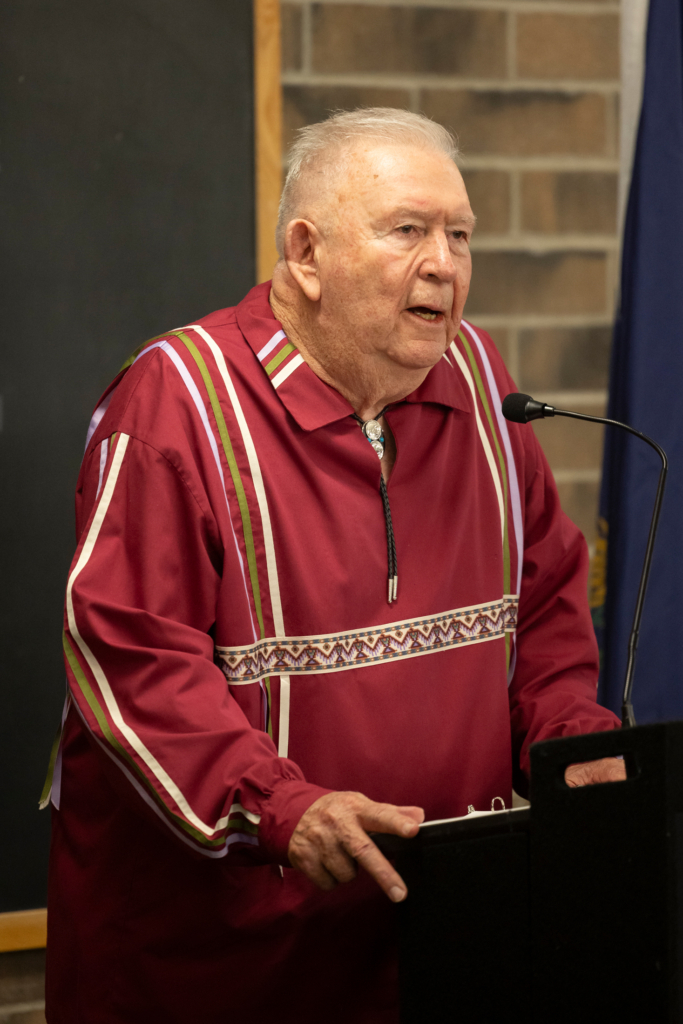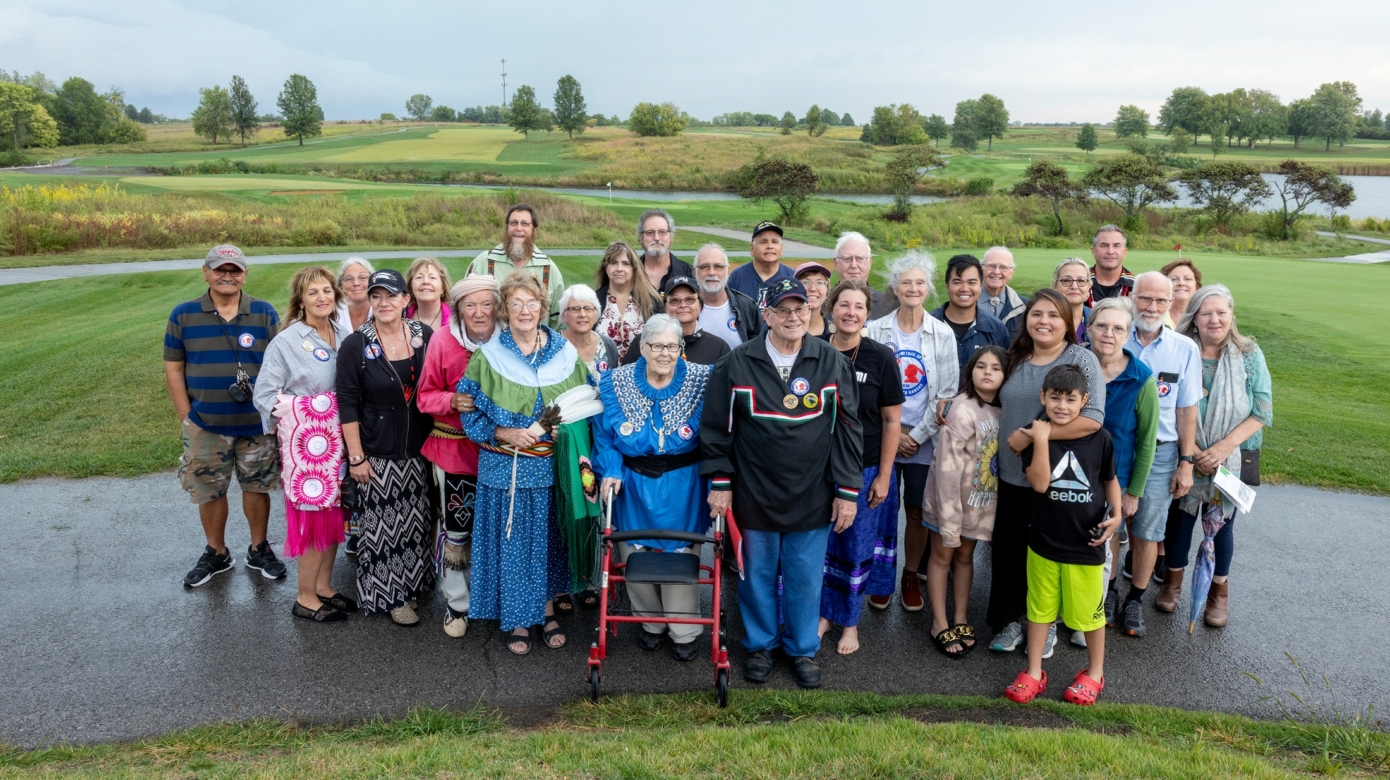Officials with the Citizen Potawatomi Nation and Tribal members from across the country met in Indiana and retraced the steps their ancestors took in 1838 when the Potawatomi were forced to leave their Indiana homelands and march to a reservation in Kansas.
The 660-mile journey became known as The Trail of Death. A band of 859 Potawatomi set out from Chief Menominee’s village near Twin Lakes, Indiana, on Sept. 4, 1838. More than 40 people died during the journey, which ended in November at a small Osage reservation in Indian Territory, now Kansas. The Potawatomi later moved to a reservation further south at Sugar Creek, Kansas.
2023 marked the 185th anniversary. Every five years, a caravan of cars retraces the journey, stopping along the way at historical markers and other sites related to the forced removal.
On Sept. 18, 2023, the group gathered at the statue of Chief Menominee in Twin Lakes to open the caravan. They visited Indiana, Illinois, Missouri and Kansas, making a brief stop on Sept. 23, 2023, in Olathe, Kansas, where CPN District 4 Legislator Jon Boursaw and the Johnson County Historical Society hosted breakfast for the participants.
A staff member for U.S. Rep. Sharice Davids, a Kansas Democrat representing the third congressional district, presented a proclamation recognizing the Trail of Death observance. Rep. Davids was unable to attend the breakfast, but had read the proclamation on the U.S. House floor earlier in the week.
CPN legislators Jon Boursaw, District 4, Alan Melot, District 1, and Bob Whistler, District 3, accepted the framed document on behalf of the Nation.
“This is sacred ground for us, for our grandparents and our ancestors,” Melot said of the journey.
Boursaw described how his great-great-great-grandfather, Daniel Bourassa, II, was among the Potawatomi who were held under guard in a church before they were forced to grab what they could prior to setting out on the enforced march. Their homes, crops and businesses were burned to discourage their return.

“The tribal leaders were placed in chains and loaded into wagons, elders were placed in wagons and over 850 men, women and children left Twin Lakes, most on foot,” he said. “Along the way, more than 40 Potawatomi, mostly elders and children, died. Over 60 were able to escape.”
The group didn’t have adequate food or water. Several townspeople along the way were compassionate, offering what they could to help the Potawatomi, Boursaw said. In some towns they passed through, local women gathered what food they could and gave it to the Potawatomi, who had received rotten rations from the U.S. Army.
A Catholic priest, Fr. Benjamin Marie Petit, insisted on accompanying the Potawatomi and recorded the events in his journal, one of the few who documented the events. Father Petit attempted to minister to the sick and dying. His journal described the conditions as hot, dusty and dry, and many of the makeshift encampments along the journey as “a scene of desolation; on all sides were the sick and dying.”
Once the Potawatomi arrived at Sugar Creek, Kansas, the housing the U.S. government promised was not there. The first winter at Sugar Creek was a difficult one, Boursaw said.
Susan Mong, superintendent of culture for Johnson County, said the county plans to develop a community art project to commemorate the Trail of Death.
“We knew art could help tell that story and create a greater sense of place and an awareness for our visitors,” Mong said. “We think this is a powerful tool to help them understand the history of this land long before it was a park.”
The county plans to have a national call for proposals, assemble an art selection committee and then choose an artist with an Indigenous background to create the art, Mong said. Johnson County is eager to receive input from the Citizen Potawatomi Nation as the project develops over the next several months, she added.
Boursaw expects the Johnson County officials and CPN representatives will meet again later to discuss ideas. He said several Tribal members expressed their interest in contributing to the project.
He appreciated the support from Mong, who “spent a considerable amount of time and effort making the arrangements” for the mid-morning stop in Olathe.
Also in attendance were CPN citizens George Godfrey, the president of the Potawatomi Trail of Death Association; Brian Wano, a descendant of Ship-she-wano; and Dr. Rosemary Schrepfer, 101. Dr. Schrepfer was the first woman to complete the obstetrician-gynecologist program in the state of Kansas.
Godfrey also introduced Shirley Willard, a former Indiana middle school teacher, who has led the effort to teach students about this chapter of Potawatomi history. She is a former president of the Fulton County (Indiana) Historical Society. Over the years, Willard has worked closely with Godfrey to organize the caravans and help share the Trail of Death story with media and local communities.
Each participant in the caravan introduced themselves and shared where they had traveled from to be a part of it. Some came from as far as California and Arizona. A few had made multiple trips in prior years while others were experiencing their first caravan. The group included a wide range of ages, from young children to elders.
The group then gathered for a photograph together before leaving for the next stop in Osawatomie, Kansas. Osawatomie received its name as it was the site where the Potawatomi joined a small group of Osage who had also been removed.
In 1838, some Osawatomie residents generously shared their food and water with the Potawatomi, but in 2023, the Potawatomi were special guests who were treated to a community meal and welcomed by town officials.
Departing Osawatomie, the caravan continued to a location near Parker, Kansas. Here, the event concluded at the St. Philippine Duchesne Memorial Park, located on what had been the Sugar Creek Reservation where the Potawatomi lived for approximately 10 years.
“I was amazed at the turnout at the event this morning in Olathe,” Boursaw said. “There were three groups, from the people on the caravan, tribal members from as far away as Wamego (Kansas) and several local residents from Johnson County. I was extremely pleased with the turnout and the support from the Johnson County officials was exceptional.”
For more information, visit the CPN Cultural Heritage Center online at potawatomiheritage.com or the Trail of Death Association website at potawatomi-tda.org. Tribal members who participated also documented their trip on Instagram at @potawatomitrail1838.

